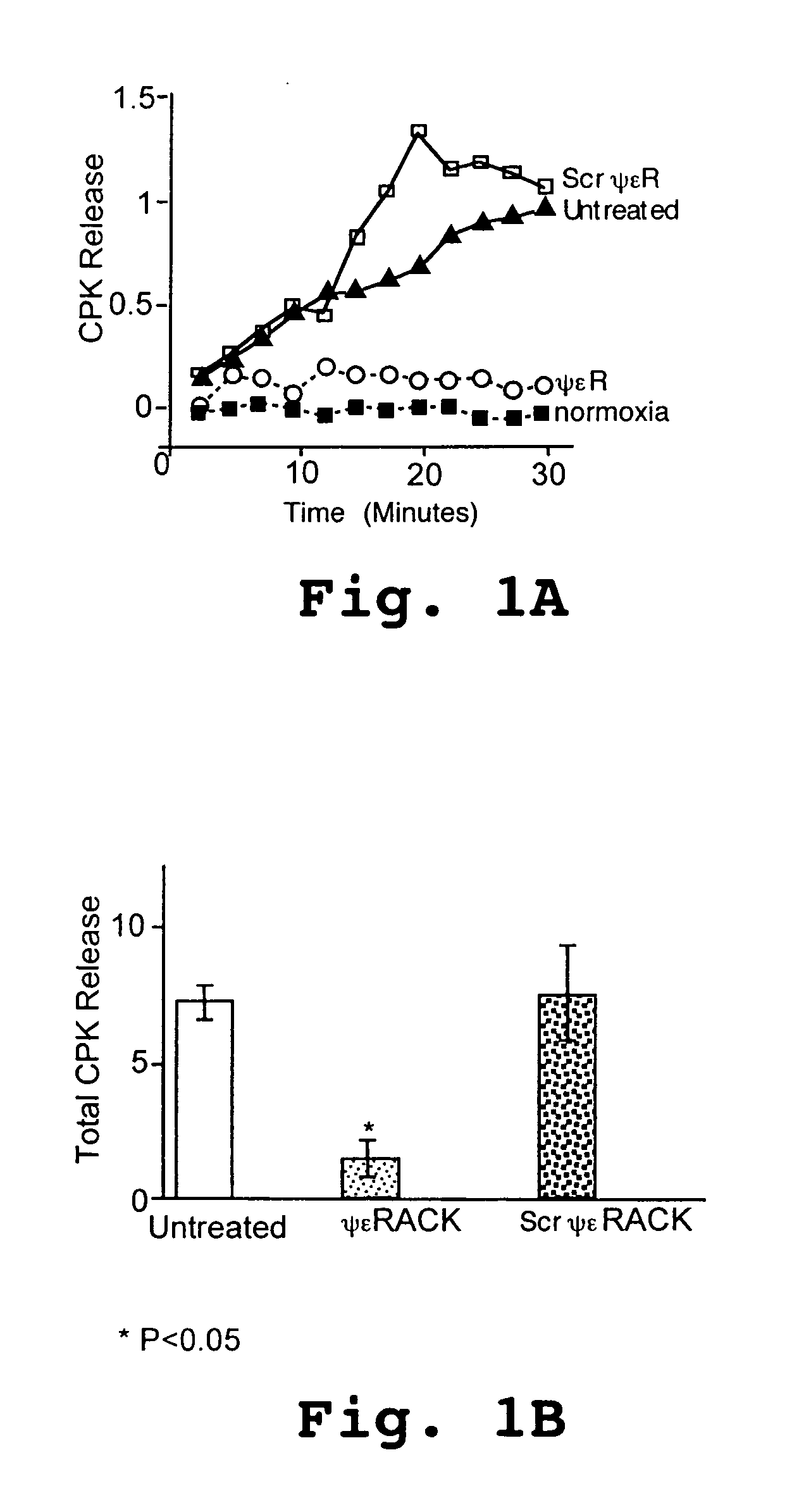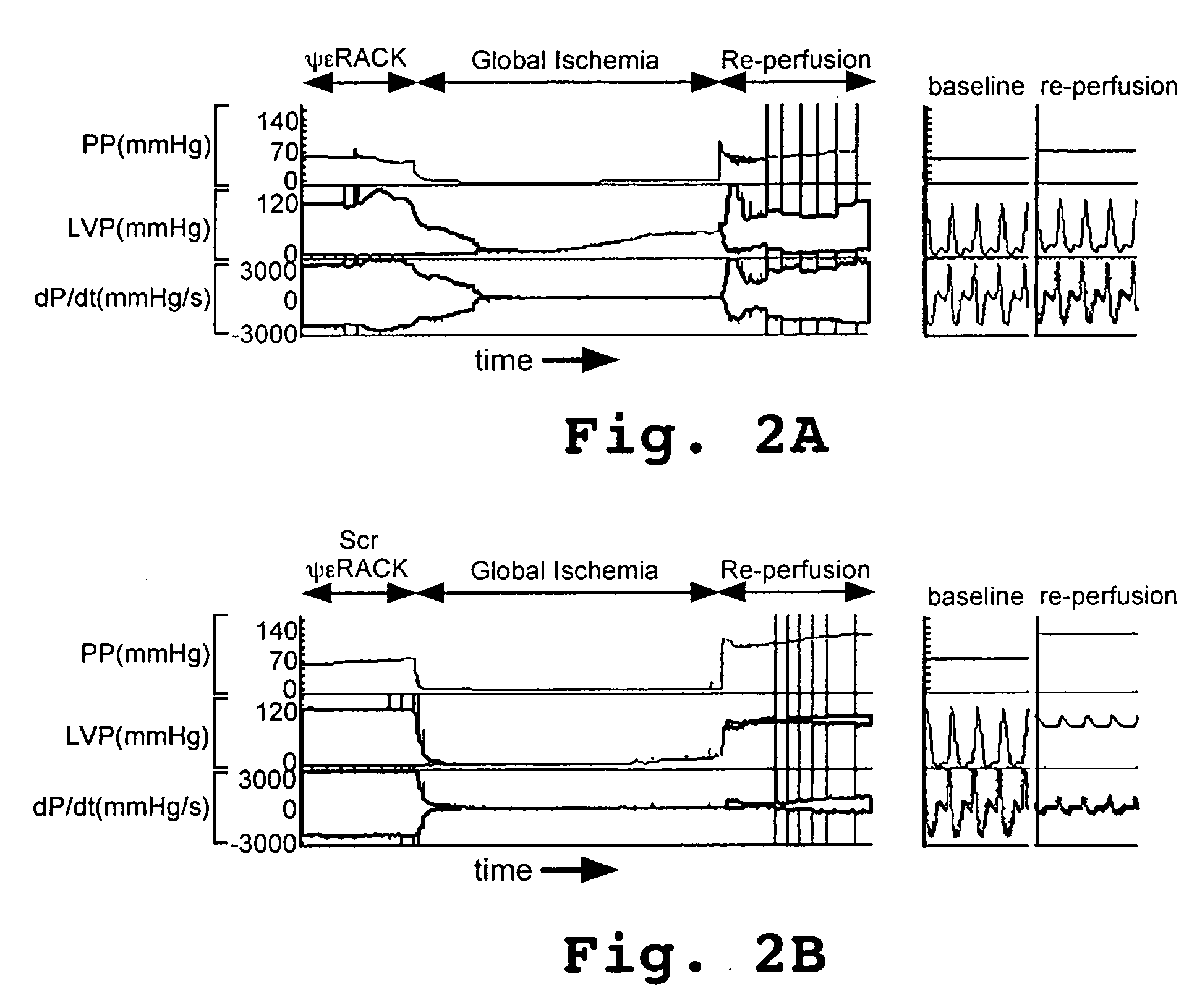ΨεRACK peptide composition and method for protection against tissue damage due to ischemia
a technology of ischemia and peptides, applied in the field of ischemia tissue damage protection, can solve the problems of inability to deliver pkc peptides, whether or not they are suitable or likely to be successful human therapies, and achieve the effect of meliorating tissue damag
- Summary
- Abstract
- Description
- Claims
- Application Information
AI Technical Summary
Benefits of technology
Problems solved by technology
Method used
Image
Examples
example 1
Ex Vivo Administration of ψεRACK Prior to Ischemia
[0126]Mice or rats were anesthetized with i.p. avertin, and their hearts were rapidly removed and cannulated via the aorta for reperfusion as described in the art (Colbert et al, 1997). Care was taken to have the hearts perfused within 90 seconds of removal. The left ventricular pressure and real-time derivative (dP / dt) were monitored via a catheter placed in the ventricular apex. Hemodynamic parameters were archived every 20 seconds throughout the procedure. The hearts were perfused with oxygenated Krebs-Henseleit solution comprised of, in nmol / L, NaCl 120; KCl 5.8; NaHCO3 25; NaH2O4 1.2; MgSO4 1.2; CaCl2 1.0; and dextrose 10, pH 7.4 at 37 C.
[0127]After a 10–20 minute equilibration period, the hearts were treated with ψεRACK peptide (SEQ ID NO:2) or with scrambled ψεRACK peptide (SEQ ID NO:4) for 20 minutes. Perfusion was maintained at a constant flow of 10 mL / min with Krebs-Henseleit solution containing 0.5 εM of the appropriate pe...
example 2
Ex Vivo Administration of ψεPKC After to Ischemia
[0129]Rat hearts were prepared as described in Example 1. After a 30 minute equilibration period, global ischemia was induced by interrupting fluid flow for 45 minutes. The hearts were then reperfused with 0.5 μM of ψεRACK peptide for 20 minutes, followed by 40 minutes of reperfusion without the peptide. As a control, some hearts were left untreated after ischemia. During the 60 minute period following ischemia, ischemia-induced cell damage was determined by monitoring the creatine phosphokinase (CPK) activity (absorbance at 520 nm) in the perfusate collected during reperfusion. The results are shown in FIGS. 3A–3B.
example 3
In Vivo Administration of ψεPKC Prior to Ischemia
[0130]Young adult female pigs, 35–40 kg in weight, were anesthetized and a catheter was introduced through the carotid artery into the heart. Using conventional intervention cardiology techniques, a wire was placed through a catheter and into the left anterior descending artery (LAD). A balloon was run over this wire to a site of occlusion where it was then inflated to block blood flow for 30 minutes. During the first 10 minutes of the ischemic insult, either the control scrambled ψεRACK peptide (SEQ ID NO:4, n=5) or the biologically active ψεRACK peptide (SEQ ID NO:2, n=5) was delivered by diffusion through the balloon directly downstream of the occlusion. Approximately 20 μg peptide (˜400 ng per kg body weight) was administered.
[0131]After 30 minutes of occlusion, the balloon was removed and pigs were left to recover from surgery. Five days later, the pigs were euthanized and hearts were harvested. After heart removal, the LAD was o...
PUM
| Property | Measurement | Unit |
|---|---|---|
| pressure | aaaaa | aaaaa |
| time | aaaaa | aaaaa |
| time | aaaaa | aaaaa |
Abstract
Description
Claims
Application Information
 Login to View More
Login to View More - R&D
- Intellectual Property
- Life Sciences
- Materials
- Tech Scout
- Unparalleled Data Quality
- Higher Quality Content
- 60% Fewer Hallucinations
Browse by: Latest US Patents, China's latest patents, Technical Efficacy Thesaurus, Application Domain, Technology Topic, Popular Technical Reports.
© 2025 PatSnap. All rights reserved.Legal|Privacy policy|Modern Slavery Act Transparency Statement|Sitemap|About US| Contact US: help@patsnap.com



